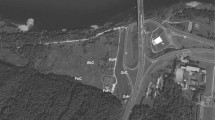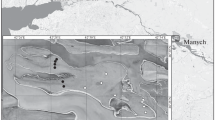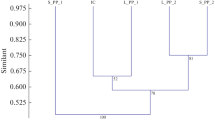Abstract
The first data on soil nematodes of coniferous forest and steppe biocenoses in the Republic of Altai were presented, thus making it possible to establish relationships between characteristics of nematode communities and vegetation features. Overall, 49 taxa of soil nematodes belonging to 31 families and nine orders were found. The results showed the highest value of nematode taxonomic diversity lying in larch forest, compared to the lowest in steppe biocenoses. The nematode population density and biomass were similarly high in the soil of forest biocenoses, but significantly exceeded those in the steppe. Variations in the eco-trophic structure of soil nematode communities among the study biocenoses were revealed. In the pine forest with Pinus sibirica, bacterial feeders and nematodes associated with plants prevailed in the soil, this being typical of various types of pine forest, compared to bacterial feeders, plant parasites, and fungal feeders which dominated in the larch forest. Nematode communities in steppe soils showed specific features and differed markedly from those in forest biocenoses, the community structure being incomplete, with dominance of fungal feeders and/or omnivores. Based on the ecological indices (Structure index SI, Enrichment index EI) calculated for nematode communities and the state of the food web described, the soil ecosystems of forest biocenoses were assessed as undisturbed, with complex food webs and a moderate level of soil organic matter enrichment. The steppe biocenosis formed by chee grass Stipa splendens, on the contrary, was characterized by SI and EI values indicating a simplified and unstable food web associated with degraded soil ecosystems under the influence of unfavorable environmental factors (climatic or anthropogenic). This shows the possible effect of extreme conditions on soil nematodes formed in the steppe of the Kosh-Agachskii region. The CI (Channel index) values of the predominant pathway of organic matter decomposition in the soil varied depending on the type of biocenosis. In Siberian stone pine and larch forests, low CI values were found, indicating the active participation of bacteria in the decomposition of organic matter in the soil. This is not typical of forest biocoenoses of other zones (for example, coniferous forests of Karelia), where soil fungi dominate in the decomposition of organic matter. In this study, a similar situation was observed in the steppe biocenosis, where the CI values were high and indicate the dominance of soil fungi in the processes of organic matter decomposition.

Similar content being viewed by others
REFERENCES
Abebe, E., Andrassy, I., and Traunspurger, W., Freshwater Nematodes: Ecology and Taxonomy, Wallingford: CABI Publishing, 2006.
Achimova, A.A., Flora of the left bank of the Katun River (Central Altai), Extended Abstract of Cand. Sci. (Biol.) Dissertation, Novosibirsk, 2005.
Bakonyi, G. and Nagy, P., Temperature- and moisture-induced changes in the structure of the nematode fauna of a semiarid grassland—patterns and mechanisms, Global Change Biol., 2000, vol. 6, pp. 696–707.
van Bezooijen, J., Methods and Techniques for Nematology, Wageningen: Wageningen University Press, 2006.
Bhusal, D.R., Tsiafouli, M.A., and Sgardelis, S.P., Temperature-based bioclimatic parameters can predict nematode metabolic footprints, Oecologia, 2015, vol. 179, no. 1, pp. 187–199.
Boag, B., Nematodes associated with forest and woodland trees in Scotland, Ann. Appl. Biol., 1974, vol. 77, pp. 41–50.
Bongers, T., The maturity index: an ecological measure of environmental disturbance based on nematode species composition, Oecologia, 1990, vol. 83, pp. 14–19.
Efremova, E.A. and Marchenko, V.A., Sheep helminths of the suborder Strongylata and features of their territorial distribution in the Altai Republic, Vet. Vrach, 2017, no. 4, pp. 53–59.
Eroshenko, A.S. and Volkova, T.V., Ecological and faunistic analysis of root nematodes of coniferous-deciduous forests of the Ussuriyskii Nature Reserve, in Paraziticheskie nematody rastenii i nasekomykh (Parasitic Nematodes of Plants and Insects), Moscow: Nauka, 2004, pp. 32–45.
Ferris, H., Bongers, T., and de Goede, R.G.M., A framework for soil food web diagnostics: extension of the nematode faunal analysis concept, Appl. Soil Ecol., 2001, vol. 18, pp. 13–29.
Gruzdeva, L.I., Matveeva, E.M., and Kovalenko, T.E., Soil nematode fauna of various forest types in the Kivach Nature Reserve, Tr. Karel. Nauchn. Tsentra Ross. Akad. Nauk, 2006, no. 10, pp. 14–21.
Hammer, Ø., Harper, D.A.T., and Ryan, P.D., PAST: paleontological statistics software package for education and data analysis, Palaeontol. Electron., 2011, vol. 4, no. 1, pp. 1–9. http://palaeo-electronica.org/2001_1/past/issue1_01.htm.
Háněl, L., Succession of soil nematodes in pine forests on coal-mining sands near Cottbus, Germany, Appl. Soil Ecol., 2001, vol. 16, pp. 23–34.
Háněl, L., Nematode assemblages indicate soil restoration on colliery spoils afforested by planting different tree species and by natural succession, Appl. Soil Ecol., 2008, vol. 40, pp. 86–99.
van den Hoogen, J., Geisen, S., Routh, D., Ferris, H., Traunspurger, W., et al., Soil nematode abundance and functional group composition at a global scale, Nature, 2019, vol. 572, pp. 194–198.
Kalashnikova, S.A. and Kartashev, A.G., The structure of soil nematode communities in the upper soil horizons of spruce and pine, Vestn. Sovrem. Issled., 2018, no. 2.2 (17), pp. 18–21.
Kalinkina, D.S., Sushchuk, A.A., and Matveeva, E.M., Characteristics of soil nematode communities under conditions of woody plant introduction, Russ. J. Ecol., 2016, vol. 47, no. 5, pp. 473–479.
Kalinkina, D.S., Sushchuk, A.A., and Krivorot, I.V., Peculiarities of soil nematode communities in different zones of the phytogenic tree field, in Bioraznoobrazie parazitov (Parasite Biodiversity), Tr. Tsentra Parazitol., Moscow: KMK, 2018, vol. L, pp. 95–97.
Kitagami, Y., Kanzaki, N., and Matsuda, Y., Distribution and community structure of soil nematodes in coastal Japanese pine forests were shaped by harsh environmental conditions, Appl. Soil Ecol., 2017, vol. 119, pp. 91–98.
Kravchenko, I.A. and Vlasova, O.E., Parasites of exotic animals in the Altai Territory, Vestn. Vet., 2011, no. 4 (59), pp. 68–69.
Kudrin, A.A. and Lapteva, E.M., Diversity and population density of soil nematodes in the floodplain forests of the valley of the middle reaches of the Pechora River, Vestn. IB Komi NTs UrO Ross. Akad. Nauk, 2015, no. 5 (193), pp. 25–29.
Kudrin, A.A., Konakova, T.N., and Taskaeva, A.A., Communities of soil nematodes of various tundra phytocenoses differing in the development level of the shrub layer, Russ. J. Ecol., 2019, vol. 50, no. 6, pp. 526–534.
De Ley, P. and Blaxter, M., A new system for Nematoda: combining morphological characters with molecular trees, and translating clades into ranks and taxa, Nematol. Monogr. Perspect., 2004, vol. 2, pp. 633–653.
Magnusson, C., Abundance and trophic structure of pine forest nematodes in relation to soil layers and ground cover, Holarctic Ecol., 1983, vol. 6, no. 2, pp. 175–182.
Matveeva, E.M. and Sushchuk, A.A., Features of soil nematode communities in various types of natural biocenoses: effectiveness of assessment parameters, Biol. Bull. (Moscow), 2016, vol. 43, no. 5, pp. 474–482
Mincheva, Y., Lazarova, S., and Peneva, V., Nematode assemblages from Mountain Pine (Pinus mugo Turra) communities in Pirin Mountain, Bulgaria, Helminthologia, 2009, vol. 46, no. 1, pp. 49–58.
Mudarisova, M.R., Exogenous processes of relief formation in the basin of the middle reaches of the Chuya River, Bachelor’s Thesis, Tomsk, 2016. https://vital.lib.tsu.ru/vital/access/manager/Repository/vital:2530.
Odum, E., Fundamentals of Ecology, Philadelphia: Saunders, 1971, 3rd ed.
Ponomarev, N.M. and Luneva, N.A., Fauna of nematodes parasitizing agricultural animals of the Altai Territory, Vestn. Altai. Gos. Agrar. Univ., 2018, no. 1 (159), pp. 134–137.
Raabe, U. and Brandes, D., Flora und Vegetation der Dörfer im nordöstlichen Burgenland, Phytocoenologia, 1988, vol. 16, no. 2, pp. 225–258.
Remezov, A.O., Wood nematodes: distribution and assessment of their pathogenicity for conifers in the Altai Territory and the Altai Republic, Extended Abstract of Cand. Sci. (Biol.) Dissertation, Barnaul, 2005.
Renčo, M. and Čerevková, A., Long-term effects of a wildfire on the soil nematode communities in the spruce forest ecosystem of High Tatra National Park, Int. J. Wildland Fire, 2015, vol. 24, pp. 702–711.
Robertus, Yu.V., Yashina, T.V., Bailagasov, L.V., Artemov, I.A., D’yakov, I.B., et al., Osobo okhranyaemye prirodnye territorii Respubliki Altai. Sovremennoe sostoyanie i perspektivy razvitiya (Specially Protected Natural Territories of the Republic of Altai. Current State and Development Prospects), Krasnoyarsk: Vsemirnyi Fond Dikoi Prirody (WWF) Russia, 2012.
Ruess, L., Nematode soil faunal analysis of decomposition pathways in different ecosystems, Nematology, 2003, vol. 5, no. 2, pp. 179–181.
Shmatko, V.Yu. and Il’ina, L.P., Characteristics of ecological and faunistic complex of soil nematodes in dry-steppe landscapes in Manych Valley, Arid Ecosyst., 2017, vol. 7, no. 3, pp. 191–202.
Shmatko, V.Yu., Sushko, K.S., Sokolova, T.A., and Il’ina, L.P., Seasonal dynamics of the structure of soil nematode communities in chestnut soils affected by grazing pressure in the Manych River valley, Arid Ecosyst., 2021, vol. 11, no. 1, pp. 91–101.
Sieriebriennikov, B., Ferris, H., and de Goede, R.G.M., NINJA: an automated calculation system for nematode-based biological monitoring, Eur. J. Soil Biol., 2014, vol. 61, pp. 90–93.
Smolik, J.D. and Rogers, L.E., Effects of cattle grazing and wildfire on soil-dwelling nematodes of the shrub-steppe ecosystem, J. Range Manage., 1976, vol. 29, no. 4, pp. 304–306.
Sohlenius, B., Influence of climatic conditions on nematode coexistence: a laboratory experiment with a coniferous forest soil, Oikos, 1985, vol. 44, no. 3, pp. 430–438.
Sohlenius, B. and Bostrom, S., Annual and long-term fluctuations of the nematode fauna in a Swedish Scots pine forest soil, Pedobiologia, 2001, vol. 45, pp. 408–429.
Solov’eva, G.I., Ekologiya pochvennykh nematod (Ecology of Soil Nematodes), Leningrad: Nauka, 1986.
Sushchuk, A.A., Kalinkina, D.S., and Platonova, E.A., Soil nematode communities under the non-native trees in the Botanic Garden of Petrozavodsk State University, Hortus Bot., 2016, vol. 11, pp. 184–197. http://hb.karelia.ru/journal/article.php?id=3442.
Sushchuk, A.A., Matveeva, E.M., and Kalinkina, D.S., Soil nematodes of forest biocenoses of protected areas of the Republic of Karelia, Tr. Karel. Nauchn. Tsentra Ross. Akad. Nauk, 2017, no. 4, pp. 49–61.
Sushchuk, A.A., Matveeva, E.M., Kalinkina, D.S., and Krivorot, I.V., Communities of soil nematodes in tundra and taiga ecosystems (on the example of the North-West of Russia), in Materialy XVIII Vseros. soveshch. “Problemy pochvennoi zoologii” (Proc. XVIII All-Russia Meet. “Problems of Soil Zoology”), Moscow: KMK, 2018, pp. 196–197.
Sushchuk, A.A., Matveeva, E.M., Butorina, N.N., Popova, E.N., Popov, I.O., and Gagarin, V.G., Comparative analysis of the soil nematode communities in meadows and agrocenoses: regional features, Russ. J. Nematol., 2019, vol. 27, no. 2, pp. 156–157.
de Vries, F.T., Liiri, M.E., Bjornlund, L., Bowker, M.A., Christensen, S., et al., Land use alters the resistance and resilience of soil food webs to drought, Nat. Climate Change, 2012, vol. 2, pp. 276–280.
Wall-Freckman, D. and Huang, S.P., Response of the soil nematode community in a shortgrass steppe to long-term and short-term grazing, Appl. Soil Ecol., 1998, vol. 9, pp. 39–44.
Yeates, G.W., Bongers, T., de Goede, R.G.M., Freckman, D.W., and Georgieva, S.S., Feeding habits in soil nematode families and genera: an outlain for soil ecologists, J. Nematol., 1993, vol. 25, no. 3, pp. 315–331.
Yeates, G.W., Wardle, D.A., and Watson, R.N., Relationships between nematodes, soil microbial biomass and weed-management strategies in maize and asparagus cropping systems, Soil Biol. Biochem., 1993a, vol. 25, no. 7, pp. 869–876.
Yeates, G.W., Hawke, M.F., and Rijkse, W.C., Changes in soil fauna and soil conditions under Pinus radiata agroforestry regimes during a 25-year tree rotation, Biol. Fertil. Soils, 2000, vol. 31, pp. 391–406.
Yuste, J.C., Penuelas, J., Estiarte, M., Garcia-Mas, J., Mattana, S., et al., Drought-resistant fungi control soil organic matter decomposition and its response to temperature, Global Change Biol., 2011, vol. 17, pp. 1475–1486.
Zhang, G., Sui, X., Li, Y., Jia, M., Wang, Zh., Han, G., and Wang, L., The response of soil nematode fauna to climate drying and warming in Stipa breviflora desert steppe in Inner Mongolia, China, J. Soils Sediments, 2020, vol. 20, pp. 2166–2180.
Zvyagintsev, D.G., Bab’eva, I.P., and Zenova, G.M., Biologiya pochv: Uchebnik (Soil Biology: Textbook), Moscow: Mosk. Gos. Univ., 2005.
FUNDING
The study was carried out under state order to Institute of Biology of Karelian Research Centre, Russian Academy of Sciences (project no. 122032100130-3).
Author information
Authors and Affiliations
Corresponding author
Ethics declarations
The authors declare that they have no conflicts of interest. This article does not contain any studies involving animals or human participants performed by any of the authors.
Rights and permissions
About this article
Cite this article
Sushchuk, A.A., Matveeva, E.M., Kalinkina, D.S. et al. Soil Nematode Communities of Typical Biocenoses in the Republic of Altai. Biol Bull Russ Acad Sci 50, 1635–1647 (2023). https://doi.org/10.1134/S1062359023070282
Received:
Revised:
Accepted:
Published:
Issue Date:
DOI: https://doi.org/10.1134/S1062359023070282




